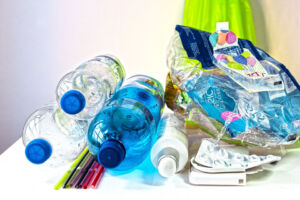Recognising Plastics

Recognising plastics is essential for recycling, quality control and application in products. Various techniques and tests help identify specific types of plastics. Here are some of the most common methods:
1. Surface inspection
A visual inspection of the surface can already give clues about the type of plastic:
- Colour and texture: Some plastics have unique characteristics, such as a matt or glossy finish.
- Imprint or symbols: A recycling code is often displayed, such as a triangular symbol with a number (1 to 7). These symbols indicate which type of plastic it is, such as PET (1), HDPE (2), or PVC (3).
2. Density test
Each plastic has a unique density, and by looking at whether the material floats or sinks in water, you can distinguish certain types:
- Polyethylene (PE) and polypropylene (PP) often float in water.
- Polyvinyl chloride (PVC), polystyrene (PS), and polycarbonate (PC) sink.
3. Bend and break test
The behaviour of a plastic when bending and breaking can provide information:
- Bros versus flexible: For example, PS and acrylic (PMMA) are more brittle than PE and PP, which tend to be pliable.
- Return: Some plastics such as PP have high springback after bending.
4. Fire test
Note that this test must be carried out carefully and safely because of the smoke and fumes that may be generated. The fire test involves lighting a small piece of plastic to analyse the colour of the flame, smell of the smoke, and behaviour of the material:
- PE and PP burn with a blue flame and smell like candle wax.
- PVC burns harder, causes soot, and has a sharp chlorine-like odour.
- PMMA (Acrylic) Burns with a bright yellow flame and smells of fruity methyl methacrylate fumes.
5. Finger rub test
By quickly rubbing the surface of the plastic material, you can generate heat:
- Some plastics, such as PVC, have a distinct odour that is released upon friction (often a slightly chlorine-like smell).
- PE and PP usually have no smell in this test.
6. Solubility test
Certain solvents can dissolve or attack specific plastics:
- Acetone rapidly dissolves polystyrene (PS) and also causes swelling in PVC.
- Alcohol does not affect some plastics, but may affect polystyrene and acetate.
7. Identification with spectroscopy
For accurate identification of plastics, industrial laboratories often use spectroscopy, such as:
- FTIR (Fourier Transformed Infrared Spectroscopy): This can be used to obtain a unique IR spectrum, which serves as a fingerprint for identifying the plastic.
- Raman spectroscopy: Also an accurate method to recognise molecular structures.
Summary of Recognition Methods:
| Method | Application |
|---|---|
| Surface inspection | Simple and often indicative |
| Density test | Useful for primary identification |
| Bend and break test | Defining flexibility and friability |
| Fire test | Identification based on odour and flame colour |
| Finger rub test | For odour determination in friction |
| Solubility test | Reaction to specific solvents |
| Spectroscopy | Highly accurate, laboratory test |
Each method can be useful in specific situations. For example, in a recycling context, simple tests are often used, while laboratories apply more sophisticated techniques for accurate material identification.